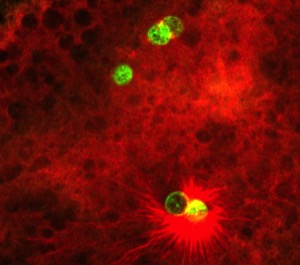Lab People |
Lab Alumni |
Publications | Contact Us | Photos |
Welcome
Research Overview
The research of Dr. Andrew Swan and his group uses the fruit fly, Drosophila melanogaster, as a model system for studying how the cell cycle is regulated and modified in development. Our work focuses on two major subjects:
Role of the SCF-Skp2 ubiquitin ligase in maintaining genome stability
A major focus of our lab is on the regulation of S-phase in the cell cycle. The entry into S-phase is the most carefully regulated decision made by the cell, and many of the known oncogenes and tumour suppressors act at this point. The SCF complex plays a critical role in S-phase regulation, functioning both as a tumour suppressor and as an oncogene in different contexts. We have focused on the less understood tumour suppressive roles of SCF-Skp2. We found that loss of Skp2 or an interacting protein, Cks85A results in inappropriate DNA replication and consequent genome instability in Drosophila. To determine how this complex maintains genome stability, are characterizing interacting proteins and ubiquitinated targets of the SCF-Skp2, employing a combined biochemical and genetic approach.
Spatial and temporal control of cell cycle transitions in meiosis and embryogenesis
One of our major focuses is on female meiosis and the ensuing mitotic cell cycles of early embryogenesis. These two cell cycle programs are very different from each other and from the typical cell cycle. Meiosis is the most complex and atypical of all cell divisions, and requires a major retooling of the cell cycle machinery that is still not well understood. The early embryonic cell cycle in contrast, is a pared-down, somewhat unregulated cell cycle, consisting of only S-phase and mitosis. Though these cell cycle programs are very different from each other, they occur within minutes of each other in a common cytoplasm, utilizing a common pool of cell cycle regulators that are deposited into the egg during oogenesis. These unique constraints mean that cell cycle regulators must be under very sophisticated temporal and spatial control. We are using a combination of approaches to examine how female meiosis and the early embryonic divisions are regulated.

